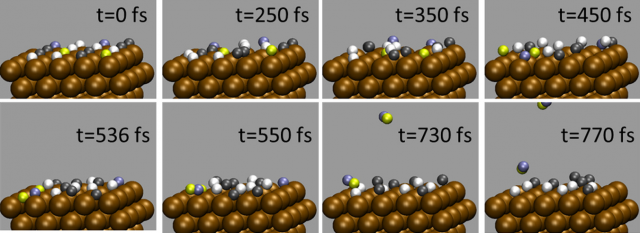Non-adiabatic effects in gas-surface interactions
Adsorption commonly is understood as the reversible binding of molecules and atoms from the gaseous or liquid phase on surfaces, mostly of highly porous adsorbent media. In chemisorption a single layer of molecules, atoms or ions is attached to the adsorbent surface by chemical bonds; in physisorption only van der Waals forces are involved.
The technical applications of adsorption cover a wide range, such as separation, synthesis, storage, purification of gases and liquids, and air conditioning. It is increasingly becoming established in chemical processes as an alternative to the conventional separation techniques of rectification, absorption, condensation, drying, extraction, membrane processes, and catalysis, and it profits from various and optimally tailored adsorbents. It is apparent that all these technical applications are considerably based on a better understanding of the surface science implied.
In the case of gas-surface interactions some approximations are made in order to understand the adsorption process from the molecular point of view. As in the case of purely classical thermodynamical processes, where an ideal irreversible one is considered, meaning that changes are small – infinitesimal – and continuous, a similar assumption is used when considering the quantum approach to the processes involved. This is called an adiabatic approximation.
In any adiabatic approximation, the time dependence of the parameters, say the inter-nuclear distance between the atoms, varies slowly. This means that the solution to the Schrödinger equation at one time goes continuously over to the solution at a later time. The adiabatic approximation was first proposed by Max Born and Vladimir Fock.
An adiabatic approximation in which the motion of atomic nuclei is taken to be so much slower than the motion of electrons that, when calculating the motions of electrons, the nuclei can be taken to be in fixed positions was developed my Max Born and Julius Oppenheimer. The use of the so-called Born-Oppenheimer approximation has been extraordinarily successful in the study of gas-surface elementary processes. However, in metal surfaces low energy electronic excitations are generated by thermal molecules, thus breaking the required smoothness of the adiabatic assumption.
Therefore, it is important to develop dynamical simulations that incorporate these non-adiabatic effects to analyze in which way they affect most common gas-surface reactions.

Now, researchers from CFM and DIPC review 1 recent theoretical developments in this problem and their application to the study of the effect of electronic excitations in the adsorption and relaxation of atoms and molecules in metal surfaces, in scattering processes, and also in recombinative processes between impinging atoms and adsorbates at the surface.
The accurate description of the gas particle-metal surface interaction is achieved in current state-of-the-art calculations with the use of density functional theory (DFT). Molecular dynamics simulations performed on precalculated DFT potential energy surfaces, including or not surface motion to account for phonon excitations, have become the standard approach in the treatment of these problems. However, in the last years, a growing interest has arisen concerning the role played by electronic excitations in dynamic gas/surface phenomena. The challenge consists in including non-adiabatic effects in molecular dynamics simulations without losing the accuracy achieved in the adiabatic description of the problem. The authors concentrate in an approach to this end called local density friction approximation (LDFA) and arrive to some conclusions.
The first is that the method can be easily implemented into multidimensional molecular dynamics simulations performed in precalculated DFT potential energy surfaces and into ab initio molecular dynamics. The resulting ab initio molecular dynamics with electronic friction method is the most complete approach to simulate gas/surface dynamics available to date.
Other important conclusions are that adsorption probabilities are not expected to be much affected by non-adiabatic effects; that non-adiabatic effects are more relevant the lighter the involved gas species is; and that LDFA can only characterize appropriately non-adiabatic effects when they involve low-energy electronic excitations.
In any case, the ab initio molecular dynamics with electronic friction method will be a useful framework in the modelling and understanding of different experimental observations in the field of gas/surface dynamics.
Author: César Tomé López is a science writer and the editor of Mapping Ignorance.
References
- M. Alducin, R. Díez Muiño, J.I. Juaristi (2017) Non-adiabatic effects in elementary reaction processes at metal surfaces Progress in Surface Science doi: 10.1016/j.progsurf.2017.09.002 ↩